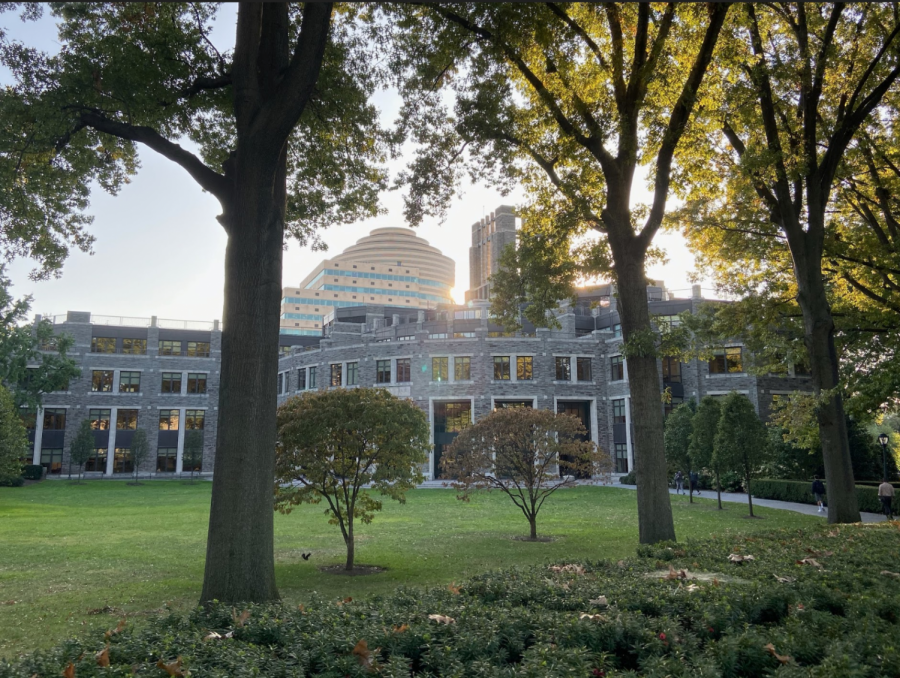Rose Hill Upgrades Sustainability with Bloom Energy
PIA FISCHETTI\THE OBSERVER
Thanks to a partnership with Bloom Energy, the Walsh Library at Rose Hill will be powered by clean energy servers starting sometime this year.
October 16, 2019
Bloom Energy, a clean energy company headquartered in San Jose, California, is set to begin installing new technology at Fordham College Rose Hill this fall. Clean-energy servers will be installed outside Walsh Library, allowing the five-story, 240,000 square-foot building to run on an independent energy grid.
BusinessWire calculated that, by using these servers, Fordham will cut down on roughly 300 metric tons of carbon dioxide each year, or “the equivalent of leaving 328,000 pounds of coal in the ground.”
The energy servers are built from fuel cells that take natural gas to make electricity. However, instead of burning natural gas, Bloom’s fuel cells use an “efficient, electrochemical process” to release the energy stored in the gas’s bonds, which completely removes the need to burn them. According to Bloom, this generates little to no carbon dioxide or methane emissions and eliminates smog-forming pollutants.
According to Bill Bockoven, vice president of the eastern region at Bloom Energy, there are no projects planned for the Lincoln Center campus at this time. “It’s a possibility if the Walsh Library project goes well,” he said, “but we haven’t looked into it.” Fordham Vice President for Facilities Management Marco Valera said that this is due to the amount of space that the devices need.
“Bloom Energy does what General Electric has been trying to do for years. The servers do not burn natural gas or produce smoke — only emitting a little bit of CO2,” said Bockoven.
According to information on Bloom’s website, one server can power a 90,000 square-foot building or 160 average U.S. homes. The fuel cells also generate their own water and heat through the process.
40% of U.S. energy use is derived from natural gas, according to Bockoven. “By 2050, we’ll continue to see the use of natural gas while coal goes down; you’re always going to need power when the sun isn’t shining and the wind isn’t blowing.”
Environmental Club Secretary Aidan Donaghy, Fordham College at Lincoln Center (FCLC) ’21, encouraged more students on campus to learn about Fordham’s energy uses.
“While I am not an expert, I do know that natural gas is only an okay solution for green energy,” he said. “It is a natural resource and the methods used to extract it can be damaging to the environment.”
Bloom Energy outsources natural gas from available pipelines, and does not involve itself in the extraction process. While Bloom’s electrochemical process does not burn natural gas, extracting it from the earth has its own set of complications. According to the Sightline Institute, roughly two-thirds of the U.S. natural gas supply comes from fracking.
Fordham has entered into a power purchase agreement with Bloom Energy, meaning the university is paying a flat rate for energy use. “Fordham doesn’t have to pay for installation or equipment,” said Bockoven. “The University wants predictable pricing. They save money and do the right thing.”
The industry standard for energy pricing is purchasing at a variable rate by the kilowatt-hour. Instead, Fordham will pay Bloom a flat fee as per the agreement. “Now Fordham is able to generate their own power 24/7,” said Bockoven.
The University’s installation will be “microgrid” ready — a localized energy source that can connect and disconnect from a larger interconnected grid — and it is becoming more popular on the east coast due to landowners’ concerns about climate change. “Customers want the ability to have power that never fails, even if the grid goes away,” said Bockoven.
Besides cleaner energy, students are pushing for more environmental initiatives: “I understand that there are space limitations at Lincoln Center, but there is always something more to do; the status quo is not working,” said Donaghy.
While Rose Hill will be the only Fordham campus to have a building go grid-independent, Fordham’s fluorescent light bulbs that run on roughly 90,000 volts will be replaced with lower-cost and more efficient LED bulbs, according to Valera.












Carol kottke • Oct 24, 2019 at 10:04 am
Great article well written!